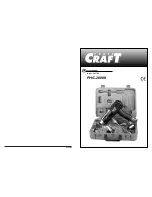
6
Powercraft
Powercraft
3
16. Avoid unintentional starting.
Do not carry plugged-in tools with finger on switch. Be
sure switch is off when plugging in.
17. Outdoor use extension cords.
When tool is used outdoors, use only extension cords
intended for use outdoors and so marked.
18. Stay alert.
Watch what you are doing. Use common sense. Do not
operate tool when you are tired.
19. Check damaged parts.
Before further use of the tool, a guard or other part that
is damaged should be carefully checked to determine
that it will operate properly and perform its intended
function. Check for alignment of moving parts, binding
of moving parts, breakage of parts, mounting, and any
other conditions that may affect its operation. A guard
or other part that is damaged should be properly
repaired or replaced by an authorized service centre
unless otherwise indicated elsewhere in this
instructions manual. Have defective switches replaced
by an authorized centre. Do not use tool if switch does
not turn it on and off.
20. Warning.
This appliance is manufactured to very high standards
and meets relevant safety regulations. Repairs should
only be done by a suitable qualified electrical engineer or
otherwise.
22. Connect the dust extraction device.
Whenever there are facilities for fitting a dust
extraction system, make sure it is connected and used.
SPECIFIC SAFETY INSTRUCTIONS
When using electric machines always observe
the safety regulations applicable in your country
to reduce the risk of fire, electric shock and
personal injury. Read the following safety
instructions and also the enclosed safety in
structions.
Keep these instructions in a safe place!
Before operating the hot air gun:
1. Check the following:
- Make sure the voltage of the hot air gun
corresponds with the power voltage.
- Are the mains lead and the mains plug in a good
state: strong, without ravels or damages.
2. Avoid the use of long extension cables.
3. Do not use the appliance under moist circumstances.
4. The metal mouthpiece gets hot. Watch out and do
not touch the metal mouthpiece.
5. Prevent damage of the heating element. Do not lock
or block the mouthpiece.
6. Do not leave the appliance when switched on.
7. When the appliance is not in use, it can be put away on
the collapsible support, which is on the air gun. By
collapsing this support, the air gun can easy be put
away on it. The hot air gun now stands on the support
with the mouthpiece up.
8. Do not use the appliance for drying hair or for drying
living human beings in general.
9. Do not use the appliance in a bath, above water or in
spaces where easy inflammable liquids are used.
Warning! This appliance operates at a
temperature of 1076 °F without visible signs of this
temperature (no flames), still there is a chance of fire risk.
Watch out for the hot air stream from the mouth piece. This
air stream can cause burns.
WHEN OPERATING THE APPLIANCE:
1. If you are going to use the hot air gun, vapours and gas
can be liberated during a short time. This can be
harmful for your health. Asthmatics can suffer
hindrance of it.
2. Before connecting the plug to the mains voltage you
have to check if the switch is in position “0”.
3. Keep the mains lead always away from the
mouthpiece of the hot air gun.
4. Keep children and animals away from the appliance if
you are using it.
IMMEDIATELY SWITCH OFF THE
APPLIANCE WHEN:
1. plug and/or cable are defective or damaged;
2. the switch is defective;
3. you smell or see smoke caused by scorched insulation
from the hot air gun.
INSTALLATION
You can work manually with this hot air gun or you can
put it in a vertical position. If you use the vertical position
the metal supporting bracket of the handgrip must also
stand vertical for supporting the handgrip on the correct
place.
USING THE APPLIANCE
THE HOT AIR GUN CAN BE USED FOR:
-
plumbing work like tube connections, solder, bowing
tubes;
-
removing paint, varnish and lacquer without fire-risk;
-
quickly drying of appliances which have become wet;
-
drying surfaces for quick repairing;
-
removing self-adhesive labels in a clean way;
-
placing PVC labels;
-
blistering after sticking PVC materials can be
smoothed after heating;
-
easy removing of vinyl carpeting;
-
forming all synthetics with a low temperature (608
°F) among which polyethylene and PVC;
-
forming all synthetics with a high temperature (1076
°F) among which acryl and plexiglass;
-
smelting synthetics, among which matters and foils
with PVC layer;
-
applying heat shrinking tubes;
-
shrinkwrappers;
-
thawing tubes and engines;
-
repairing finishing layers: email of bath and household
appliances;
-
applying epoxypowder coverlayers;
-
repairing of ski’s, surf-boards and other sports
goods;
-
unscrewing too fast fixed screws and connections.




